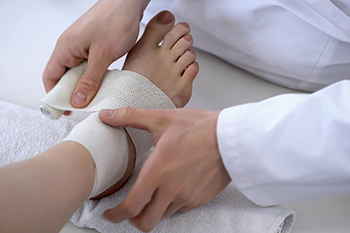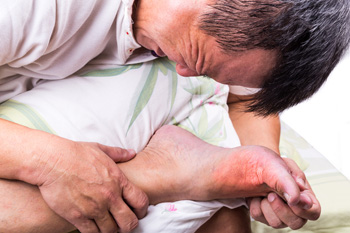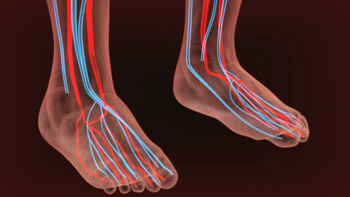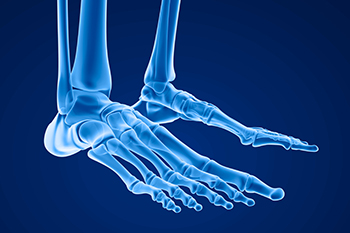Connect With Us
Blog
Items filtered by date: May 2023
Soft Tissue, Ligaments, and the Ankle

The ligaments in the ankle are made of soft tissue. If an ankle injury has occurred, healing may be slow as a result of a lack of blood flow. Damage to these ligaments can be caused while participating in physical activities, or it may happen from unexpectedly stepping off a curb. Painful arthritis may be prevented when prompt medical attention is sought if an ankle sprain has occurred. One of the functions of the ankle ligaments is to keep the shape of the bones. An X-ray is often performed that can rule out a fracture, and treatment for a sprained ankle can begin. Many people find relief when the foot is frequently elevated, and an elastic bandage is wrapped around the affected ankle. This is generally successful in providing the stability that is necessary as the healing process occurs. If the ankle sprain happens from a sporting event, it is beneficial to temporarily stop that activity until a full recovery has taken place. If you have sprained your ankle, it is suggested that you confer with a podiatrist who can help you with the treatment that is right for you.
Although ankle sprains are common, they aren’t always minor injuries. If you need your ankle injury looked at, contact one of our podiatrists from Sutera and Jones Surgical Podiatry. Our doctors can provide the care you need to keep you pain-free and on your feet.
How Does an Ankle Sprain Occur?
Ankle sprains are the result of a tear in the ligaments within the ankle. These injuries may happen when you make a rapid shifting movement while your foot is planted. A less common way to sprain your ankle is when your ankle rolls inward while your foot turns outward.
What Are the Symptoms?
- Pain at the sight of the tear
- Bruising/Swelling
- Ankle area is tender to touch
- In severe cases, may hear/feel something tear
- Skin discoloration
Preventing a Sprain
- Wearing appropriate shoes for the occasion
- Stretching before exercises and sports
- Knowing your limits
Treatment of a Sprain
In many cases, the RICE method (Rest, Ice, Compression, and Elevate) is used to treat ankle sprains. However, you should see a podiatrist to see which treatment option would work best with your injury. In severe cases, surgery may be required.
It is important to ask your doctor about rehab options after you receive treatment for your injury. Stretching, strength training, and balance exercises may help the ankle heal while also preventing further injury.
If you have any questions, please feel free to contact one of our offices located in Media, Glen Mills, Riddle Memorial Hospital, and Concordville, PA . We offer the newest diagnostic and treatment technologies for all your foot care needs.
X-Ray Needed for a Broken Ankle

A broken ankle develops when an individual breaks, or fractures, one or more of the bones in the ankle area. In order to determine whether or not the ankle has in fact been fractured, a medical professional may perform an X-ray. An ankle X-ray can look at each of the different types of bones in the ankle, including the tibia, fibula, and talus. Importantly, there are different types of views that an ankle X-ray may capture. For example, this type of X-ray can present an AP, mortise, and lateral view. Each of these different types of views show various angles of the ankle area. Having an ankle X-ray taken is helpful for a medical professional and the patient because it can illuminate which areas of the ankle have been impacted. If you are someone that has recently broken their ankle, it is suggested that you contact a podiatrist today for an appointment.
Broken ankles need immediate treatment. If you are seeking treatment, contact one of our podiatrists from Sutera and Jones Surgical Podiatry. Our doctors can provide the care you need to keep you pain-free and on your feet.
Broken Ankles
A broken ankle is experienced when a person fractures their tibia or fibula in the lower leg and ankle area. Both of these bones are attached at the bottom of the leg and combine to form what we know to be our ankle.
When a physician is referring to a break of the ankle, he or she is usually referring to a break in the area where the tibia and fibula are joined to create our ankle joint. Ankles are more prone to fractures because the ankle is an area that suffers a lot of pressure and stress. There are some obvious signs when a person experiences a fractured ankle, and the following symptoms may be present.
Symptoms of a Fractured Ankle
- Excessive pain when the area is touched or when any pressure is placed on the ankle
- Swelling around the area
- Bruising of the area
- Area appears to be deformed
If you suspect an ankle fracture, it is recommended to seek treatment as soon as possible. The sooner you have your podiatrist diagnose the fracture, the quicker you’ll be on the way towards recovery.
If you have any questions, please feel free to contact one of our offices located in Media, Glen Mills, Riddle Memorial Hospital, and Concordville, PA . We offer the newest diagnostic and treatment technologies for all your foot care needs.
What Is Gout?

Gout is a form of arthritis that can be extremely painful. Gout occurs as crystals that form in the joints of the big toe from consuming purine-rich foods. These foods include red meat, shellfish, and drinks that contain large amounts of sugar. These purines convert to uric acid, and an abundance of uric acid can cause the big toe to become inflamed. The toe may turn red and become swollen, causing the skin to pull tightly surrounding the affected joint. Many people make lifestyle choices that may lead to developing gout. Being overweight, drinking excess alcohol, and eating foods laden with purines may contribute to the onset of gout. There may be existing health conditions like high blood pressure or thyroid disorders that can lead to increased uric acid levels. If you have had one or many gout attacks, it is strongly suggested that you seek the counsel of a podiatrist who can help you to manage this uncomfortable condition.
Gout is a foot condition that requires certain treatment and care. If you are seeking treatment, contact one of our podiatrists from Sutera and Jones Surgical Podiatry. Our doctors will treat your foot and ankle needs.
What Is Gout?
Gout is a type of arthritis caused by a buildup of uric acid in the bloodstream. It often develops in the foot, especially the big toe area, although it can manifest in other parts of the body as well. Gout can make walking and standing very painful and is especially common in diabetics and the obese.
People typically get gout because of a poor diet. Genetic predisposition is also a factor. The children of parents who have had gout frequently have a chance of developing it themselves.
Gout can easily be identified by redness and inflammation of the big toe and the surrounding areas of the foot. Other symptoms include extreme fatigue, joint pain, and running high fevers. Sometimes corticosteroid drugs can be prescribed to treat gout, but the best way to combat this disease is to get more exercise and eat a better diet.
If you have any questions please feel free to contact one of our offices located in Media, Glen Mills, Riddle Memorial Hospital, and Concordville, PA . We offer the newest diagnostic and treatment technologies for all your foot and ankle needs.
Do Your Child's Feet Hurt?
What Can Cause Poor Circulation?

Having cold feet may be a symptom of poor circulation. Feet may also become numb and discolored, and there are various reasons for this condition to happen. Existing medical ailments, such as Raynaud’s disease may lead to developing poor circulation. Having acrocyanosis, which turns the feet or toes blue, may be another reason for this to occur. This condition can cause the blood vessels to constrict, and blood is prevented from moving through the feet. Patients who have diabetes often have poor circulation, and immediate medical attention is often sought that may help to prevent diabetic foot ulcers from developing. Additionally, smoking, high blood pressure and elevated cholesterol levels may cause poor circulation. There are methods that can be implemented which may help to reduce the risk. These can include performing breathing exercises, practicing meditation, and yoga, in addition to avoiding alcohol and caffeine. If you have symptoms of poor circulation, it is suggested that you confer with a podiatrist who can properly treat this condition.
While poor circulation itself isn’t a condition; it is a symptom of another underlying health condition you may have. If you have any concerns with poor circulation in your feet contact one of our podiatrists of Sutera and Jones Surgical Podiatry. Our doctors will treat your foot and ankle needs.
Poor Circulation in the Feet
Peripheral artery disease (PAD) can potentially lead to poor circulation in the lower extremities. PAD is a condition that causes the blood vessels and arteries to narrow. In a linked condition called atherosclerosis, the arteries stiffen up due to a buildup of plaque in the arteries and blood vessels. These two conditions can cause a decrease in the amount of blood that flows to your extremities, therefore resulting in pain.
Symptoms
Some of the most common symptoms of poor circulation are:
- Numbness
- Tingling
- Throbbing or stinging pain in limbs
- Pain
- Muscle Cramps
Treatment for poor circulation often depends on the underlying condition that causes it. Methods for treatment may include insulin for diabetes, special exercise programs, surgery for varicose veins, or compression socks for swollen legs.
As always, see a podiatrist as he or she will assist in finding a regimen that suits you. A podiatrist can also prescribe you any needed medication.
If you have any questions, please feel free to contact one of our offices located in Media, Glen Mills, Riddle Memorial Hospital, and Concordville, PA . We offer the newest diagnostic and treatment technologies for all your foot care needs.
What Is Morton’s Toe?

Despite being relatively small parts of the human body, the toes are critical to maintaining the health of the body and feet. The toes may be susceptible to many conditions, including hammertoe, ingrown toenails, and toenail fungus. Many patients may not be familiar with a condition known as Morton’s toe. This condition is present in a patient when their second toe is longer in length than their big toe. Therefore, Morton’s toe is defined by the relative lengths of the second and big toe. Interestingly, women are more predisposed to this condition than men. As a result of having Morton’s toe, an individual may be at an increased risk of developing calluses on the feet. Having the condition may also lead to a somewhat uneven distribution of weight. If you are living with Morton’s toe, it is recommended that you contact a podiatrist today for treatment and advice.
If you have any concerns about your feet, contact one of our podiatrists from Sutera and Jones Surgical Podiatry. Our doctors can provide the care you need to keep you pain-free and on your feet.
Biomechanics in Podiatry
Podiatric biomechanics is a particular sector of specialty podiatry with licensed practitioners who are trained to diagnose and treat conditions affecting the foot, ankle and lower leg. Biomechanics deals with the forces that act against the body, causing an interference with the biological structures. It focuses on the movement of the ankle, the foot and the forces that interact with them.
A History of Biomechanics
- Biomechanics dates back to the BC era in Egypt where evidence of professional foot care has been recorded.
- In 1974, biomechanics gained a higher profile from the studies of Merton Root, who claimed that by changing or controlling the forces between the ankle and the foot, corrections or conditions could be implemented to gain strength and coordination in the area.
Modern technological improvements are based on past theories and therapeutic processes that provide a better understanding of podiatric concepts for biomechanics. Computers can provide accurate information about the forces and patterns of the feet and lower legs.
Understanding biomechanics of the feet can help improve and eliminate pain, stopping further stress to the foot.
If you have any questions please feel free to contact one of our offices located in Media, Glen Mills, Riddle Memorial Hospital, and Concordville, PA . We offer the newest diagnostic and treatment technologies for all your foot and ankle needs.
Blog Archives
- July 2024
- June 2024
- May 2024
- April 2024
- March 2024
- February 2024
- January 2024
- December 2023
- November 2023
- October 2023
- September 2023
- August 2023
- July 2023
- June 2023
- May 2023
- April 2023
- March 2023
- February 2023
- January 2023
- December 2022
- November 2022
- October 2022
- September 2022
- August 2022
- July 2022
- June 2022
- May 2022
- April 2022
- March 2022
- February 2022
- January 2022
- December 2021
- November 2021
- October 2021
- September 2021
- August 2021
- July 2021
- June 2021
- May 2021
- April 2021
- March 2021
- February 2021
- January 2021
- December 2020
- November 2020
- October 2020
- September 2020
- August 2020
- July 2020
- June 2020
- May 2020
- April 2020
- March 2020
- February 2020
- January 2020
- December 2019
- November 2019
- October 2019
- September 2019
- August 2019
- July 2019
- June 2019
- May 2019
- April 2019
- March 2019
- February 2019
- January 2019
- December 2018
- November 2018
- October 2018
- September 2018
- August 2018
- July 2018
- June 2018
- May 2018
- April 2018
- March 2018
- February 2018
- January 2018
- December 2017
- November 2017
- October 2017
- September 2017
- August 2017
- July 2017
- June 2017
- May 2017
- April 2017
- March 2017
- February 2017
- January 2017
- December 2016
- November 2016
- October 2016
- September 2016
- August 2016
- July 2016
- June 2016
- May 2016
- April 2016
- March 2016
- February 2016
- January 2016
- December 2015
- November 2015
- October 2015
- September 2015
- August 2015
- July 2015
- June 2015
- May 2015
- April 2015
- March 2015
- February 2015
- January 2015
- December 2014
- November 2014
- October 2014
- September 2014

